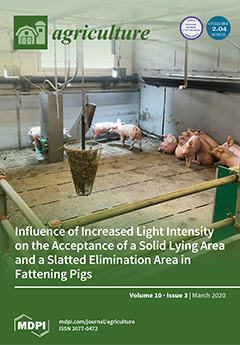Postharvest treatment by 1-methylcyclopropene (1-MCP) for ‘Szampion’ cultivar apples inhibits ripening of climacteric fruit by blocking ethylene receptors, preventing ethylene from binding and eliciting its action. It is also possible to apply 1-MCP preharvest, which so far has not been studied for the ‘Szampion’ cultivar. The aim of this study was to assess the effects of preharvest 1-MCP treatment on the fruit quality parameters of cold-stored ‘Szampion’ cultivar apples in a Polish experiment. Two identical groups of apple trees (6 years, experimental orchard in Warsaw) were included, to obtain studied apples (preharvest 1-MCP treatment with Harvista
TM, 150 g/ha, 7 days before the optimum harvesting window, OHW) and control apples (1-MCP not applied). Apples for the studied group were harvested twice—on 28 September (OHW) and 24 October (delayed harvesting)—and for control group once—on 28 September, as before 24 October the majority of apples fell from trees. Afterwards, apples were stored in an Ultra Low Oxygen chamber (1.2% CO
2, 1.2% O
2). Apples were assessed in the preharvest period (weekly, six measurements for the studied group, and five measurements for the control group) and postharvest period (monthly, three measurements separately for each harvest time for the studied group and control group). The following parameters were assessed: internal ethylene content (IEC), firmness, total soluble solids (TSS) content, starch index, Streif index, titratable acidity (TA), and color for blush. For the preharvest period, statistically significant differences between the studied group and the control group were observed for IEC, the a* coordinate of color (
p < 0.05; for apples treated with 1-MCP lower results), firmness, Streif index, TA (
p < 0.05; higher results), and starch index (
p < 0.05; no defined trend). For the postharvest period, statistically significant differences between the studied group and the control group were observed for apples harvested in the OHW for firmness (
p < 0.05; for apples treated with 1-MCP higher results) and IEC (
p < 0.05; no defined trend), while for delayed harvesting the differences were only minor. It may be concluded, that preharvest 1-MCP application makes it possible not only to obtain better results for ‘Szampion’ cultivar apples’ quality parameters, but also allows delayed harvesting without deterioration in quality.
Full article





